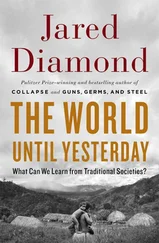Jared Diamond - Guns, Germs & Steel
Здесь есть возможность читать онлайн «Jared Diamond - Guns, Germs & Steel» весь текст электронной книги совершенно бесплатно (целиком полную версию без сокращений). В некоторых случаях можно слушать аудио, скачать через торрент в формате fb2 и присутствует краткое содержание. Жанр: 105. Описание произведения, (предисловие) а так же отзывы посетителей доступны на портале библиотеки ЛибКат.
- Название:Guns, Germs & Steel
- Автор:
- Жанр:
- Год:неизвестен
- ISBN:нет данных
- Рейтинг книги:5 / 5. Голосов: 1
-
Избранное:Добавить в избранное
- Отзывы:
-
Ваша оценка:
- 100
- 1
- 2
- 3
- 4
- 5
Guns, Germs & Steel: краткое содержание, описание и аннотация
Предлагаем к чтению аннотацию, описание, краткое содержание или предисловие (зависит от того, что написал сам автор книги «Guns, Germs & Steel»). Если вы не нашли необходимую информацию о книге — напишите в комментариях, мы постараемся отыскать её.
Guns, Germs & Steel — читать онлайн бесплатно полную книгу (весь текст) целиком
Ниже представлен текст книги, разбитый по страницам. Система сохранения места последней прочитанной страницы, позволяет с удобством читать онлайн бесплатно книгу «Guns, Germs & Steel», без необходимости каждый раз заново искать на чём Вы остановились. Поставьте закладку, и сможете в любой момент перейти на страницу, на которой закончили чтение.
Интервал:
Закладка:
inall, of the world's 148 big wild terrestrial herbivorous mammals the candidates for domestication—only 14 passed the test. Why did other 134 species fail? To which conditions was Francis Gallon re when he spoke of those other species as "destined to perpetual wildnessl
ZEBRAS AND UNHAPPY MARRIAGES • 169
The answer follows from the Anna Karenina principle. To be domesti-ated a candidate wild species must possess many different characteristics. Lack of any single required characteristic dooms efforts at domestication, just as it dooms efforts at building a happy marriage. Playing marriage counselor to the zebra / human couple and other ill-sorted pairs, we can recognize at least six groups of reasons for failed domestication.
Diet. Every time that an animal eats a plant or another animal, the conversion of food biomass into the consumer's biomass involves an efficiency of much less than 100 percent: typically around 10 percent. That is it takes around 10,000 pounds of corn to grow a 1,000-pound cow. If instead you want to grow 1,000 pounds of carnivore, you have to feed it 10,000 pounds of herbivore grown on 100,000 pounds of corn. Even among herbivores and omnivores, many species, like koalas, are too finicky in their plant preferences to recommend themselves as farm animals.
As a result of this fundamental inefficiency, no mammalian carnivore has ever been domesticated for food. (No, it's not because its meat would be tough or tasteless: we eat carnivorous wild fish all the time, and I can personally attest to the delicious flavor of lion burger.) The nearest thing to an exception is the dog, originally domesticated as a sentinel and hunting companion, but breeds of dogs were developed and raised for food in Aztec Mexico, Polynesia, and ancient China. However, regular dog eating has been a last resort of meat-deprived human societies: the Aztecs had no other domestic mammal, and the Polynesians and ancient Chinese had only pigs and dogs. Human societies blessed with domestic herbivorous mammals have not bothered to eat dogs, except as an uncommon delicacy (as in parts of Southeast Asia today). In addition, dogs are not strict carnivores but omnivores: if you are so naive as to think that your beloved pet dog is really a meat eater, just read the list of ingredients on your bag of dog food. The dogs that the Aztecs and Polynesians reared for food were efficiently fattened on vegetables and garbage.
Growth Rate. To be worth keeping, domesticates must also grow quickly. That eliminates gorillas and elephants, even though they are vegetarians with admirably nonfinicky food preferences and represent a lot of meat. What would-be gorilla or elephant rancher would wait 15 years for his herd to reach adult size? Modern Asians who want work elephants find it much cheaper to capture them in the wild and tame them.
Problems of Captive Breeding. We humans don't like to have sex under watchful eyes of others; some potentially valuable animal species don't
17o " GUNS, GERMS, AND STEEL
like to, either. That's what derailed attempts to domesticate cheetahs, the swiftest of all land animals, despite our strong motivation to do so for thousands of years.
As I already mentioned, tame cheetahs were prized by ancient Egyptians and Assyrians and modern Indians as hunting animals infinitely superior to dogs. One Mogul emperor of India kept a stable of a thousand cheetahs. But despite those large investments that many wealthy princes made, all of their cheetahs were tamed ones caught in the wild. The princes' efforts to breed cheetahs in captivity failed, and not until 1960 did even biologists in modern zoos achieve their first successful cheetah birth. In the wild, several cheetah brothers chase a female for several days, and that rough courtship over large distances seems to be required to get the female to ovulate or to become sexually receptive. Cheetahs usually refuse to carry-out that elaborate courtship ritual inside a cage.
A similar problem has frustrated schemes to breed the vicufta, an Andean wild camel whose wool is prized as the finest and lightest of any animal's. The ancient Incas obtained vicuna wool by driving wild vicunas into corrals, shearing them, and then releasing them alive. Modern mer– | chants wanting this luxury wool have had to resort either to this same method or simply to killing wild vicunas. Despite strong incentives of|f money and prestige, all attempts to breed vicunas for wool production in captivity have failed, for reasons that include vicunas' long and elaborate; courtship ritual before mating, a ritual inhibited in captivity; male vicunas' ' fierce intolerance of each other; and their requirement for both a year-1! round feeding territory and a separate year-round sleeping territory.
Nasty Disposition. Naturally, almost any mammal species that is suffi-% ciently large is capable of killing a human. People have been killed by pigs, horses, camels, and cattle. Nevertheless, some large animals have mudr| nastier dispositions and are more incurably dangerous than are others. Tendencies to kill humans have disqualified many otherwise seemingrjS ideal candidates for domestication.
One obvious example is the grizzly bear. Bear meat is an expensive delicacy, grizzlies weigh up to 1,700 pounds, they are mainly vegetarian (though also formidable hunters), their vegetable diet is very broad, thrive on human garbage (thereby creating big problems in Yellowston and Glacier National Parks), and they grow relatively fast. If they would behave themselves in captivity, grizzlies would be a fabulous meat production animal. The Ainu people of Japan made the experiment by routinely
ZEBRAS AND UNHAPPY MARRIAGES • I 7 I
ring grizzly cu^s as Part of a ritual– For understandable reasons, , ugh the Ainu found it prudent to kill and eat the cubs at the age of one Keeping grizzly bears for longer would be suicidal; I am not aware of any adult that has been tamed.
Another otherwise suitable candidate that disqualifies itself for equally obvious reasons is the African buffalo. It grows quickly up to a weight of a ton and lives in herds that have a well-developed dominance hierarchy, a trait whose virtues will be discussed below. But the African buffalo is considered the most dangerous and unpredictable large mammal of Africa. Anyone insane enough to try to domesticate it either died in the effort or was forced to kill the buffalo before it got too big and nasty. Similarly, hippos, as four-ton vegetarians, would be great barnyard animals if they weren't so dangerous. They kill more people each year than do any other African mammals, including even lions.
Few people would be surprised at the disqualification of those notoriously ferocious candidates. But there are other candidates whose dangers are not so well known. For instance, the eight species of wild equids (horses and their relatives) vary greatly in disposition, even though all eight are genetically so close to each other that they will interbreed and produce healthy (though usually sterile) offspring. Two of them, the horse and the North African ass (ancestor of the donkey), were successfully domesticated. Closely related to the North African ass is the Asiatic ass, also known as the onager. Since its homeland includes the Fertile Crescent, the cradle of Western civilization and animal domestication, ancient peoples must have experimented extensively with onagers. We know from Sumerian and later depictions that onagers were regularly hunted, as well as captured and hybridized with donkeys and horses. Some ancient depictions of horselike animals used for riding or for pulling carts may refer to onagers. However, all writers about them, from Romans to modern zookeepers, decry their irascible temper and their nasty habit of biting People. As a result, although similar in other respects to ancestral donkeys, onagers have never been domesticated.
Africa's four species of zebras are even worse. Efforts at domestication went as far as hitching them to carts: they were tried out as draft animals m 19th-century South Africa, and the eccentric Lord Walter Rothschild drove through the streets of London in a carriage pulled by zebras. Alas, ze ras become impossibly dangerous as they grow older. (That's not to eny that many individual horses are also nasty, but zebras and onagers
Интервал:
Закладка:
Похожие книги на «Guns, Germs & Steel»
Представляем Вашему вниманию похожие книги на «Guns, Germs & Steel» списком для выбора. Мы отобрали схожую по названию и смыслу литературу в надежде предоставить читателям больше вариантов отыскать новые, интересные, ещё непрочитанные произведения.
Обсуждение, отзывы о книге «Guns, Germs & Steel» и просто собственные мнения читателей. Оставьте ваши комментарии, напишите, что Вы думаете о произведении, его смысле или главных героях. Укажите что конкретно понравилось, а что нет, и почему Вы так считаете.










